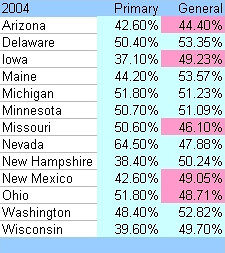"The path to 1600 Pennsylvania Avenue goes through Pennsylvania so if Barack Obama can't win there, how will he win the general election?"
Generally speaking, Clinton's approach to the Primaries is to campaign aggressively in the large swing states. Her logic implies that a strong showing in these states means a strong showing in the general election. While the argument seems sound, the general election is a very different election with very different voters.
Is this a good strategy? On a state-by-state basis, should the same candidate be able to woo democrats in the same proportion as the general electorate?
I've tabulated data from the 2004 and 2000 Democratic Party Primaries in order to better answer this question. I would have liked to include other contests, but it's (shockingly) difficult to find primary data from 1996 and before.
Blue indicates a win, red indicates a loss. Data comes from http://uselectionatlas.org/.
2004: John Kerry effectively clinched the nomination on Super Tuesday after runner-up John Edwards dropped out of the race, so I will only examine the pre-Super Tuesday swing states.

The numbers show that there is no distinct correlation between Kerry's performance in the primaries and in the general election. Though he virtually swept the swing states when campaigning against Edwards and Dean, he only won 8 out of 13 versus George Bush.
2000: Like 2004, this was also decided after Super Tuesday. Bill Bradley withdrew from the race after a resounding defeat by Al Gore. However, there were fewer swing states available during this election, so the sample size is much smaller:

Al Gore's commanding primary victory in Ohio (a state that Hillary has made the cornerstone of her campaign) resulted in a clear defeat during the general election. The only "battleground" state he won in both contests was Iowa, by only the slimmest of margins.
So what does this mean for Hillary?
The data shows that the elections are not simply decided by the state, but by the race at hand. Claiming to be able to win certain states simply by the primary results is a serious error, as common sense would indicate.
One last thing: Hillary's campaign promises a strong showing in swing states. But the current list of swing states doesn't seem to agree:

Not only is Hillary's logic flawed, she's not even winning the swing states! Of course, her campaign realizes this, and has declared that the states she lost are the "latte-sipping" boutique states. Regardless, even latte-sippers have delegates, and those delegates count at the national convention.
Notes:
There's obviously a lot more that could be done with the election data, but I'm no statistician.
I'm only working with popular vote numbers-- Which, as we learned in 2000, is not always a clear indicator of who wins the contest.
1 comment:
Yah, but if Obama were white, Hillary would be winning all the states!
Post a Comment